外研 高中英语选 修8Module 2 The Renaissance review of Non-finite verbs课件(共47张)
文档属性
| 名称 | 外研 高中英语选 修8Module 2 The Renaissance review of Non-finite verbs课件(共47张) | 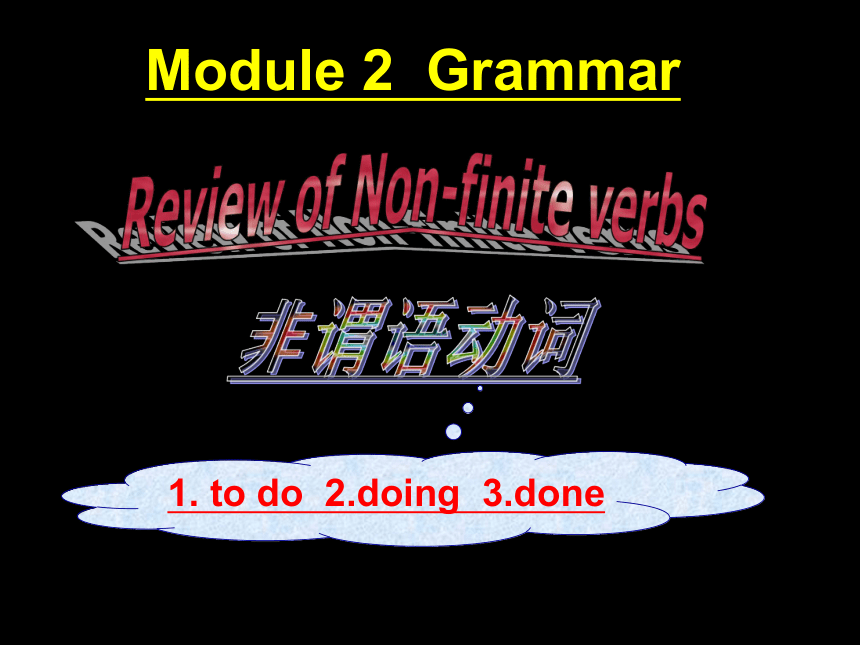 | |
| 格式 | zip | ||
| 文件大小 | 2.9MB | ||
| 资源类型 | 教案 | ||
| 版本资源 | 外研版 | ||
| 科目 | 英语 | ||
| 更新时间 | 2019-06-02 06:48:41 | ||
图片预览

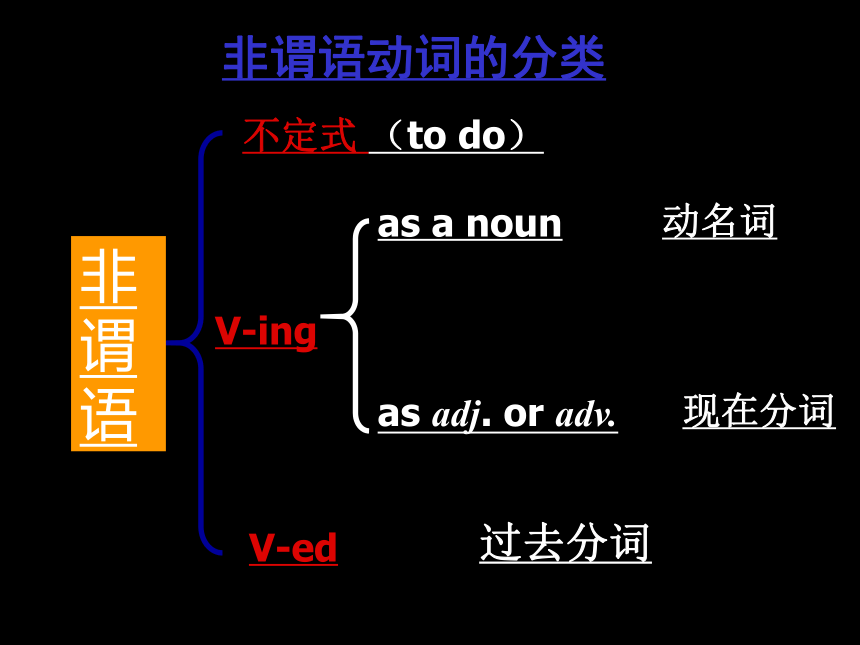
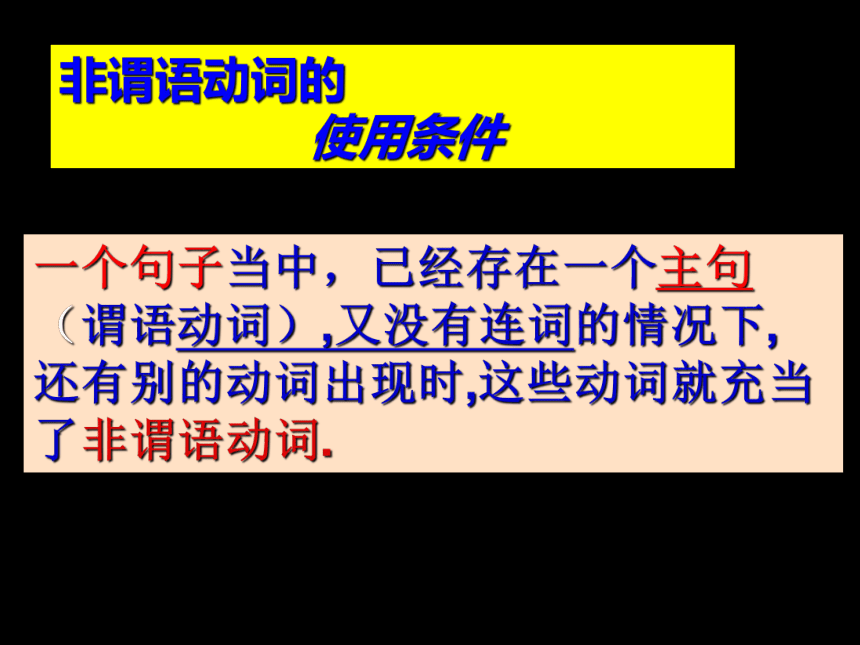

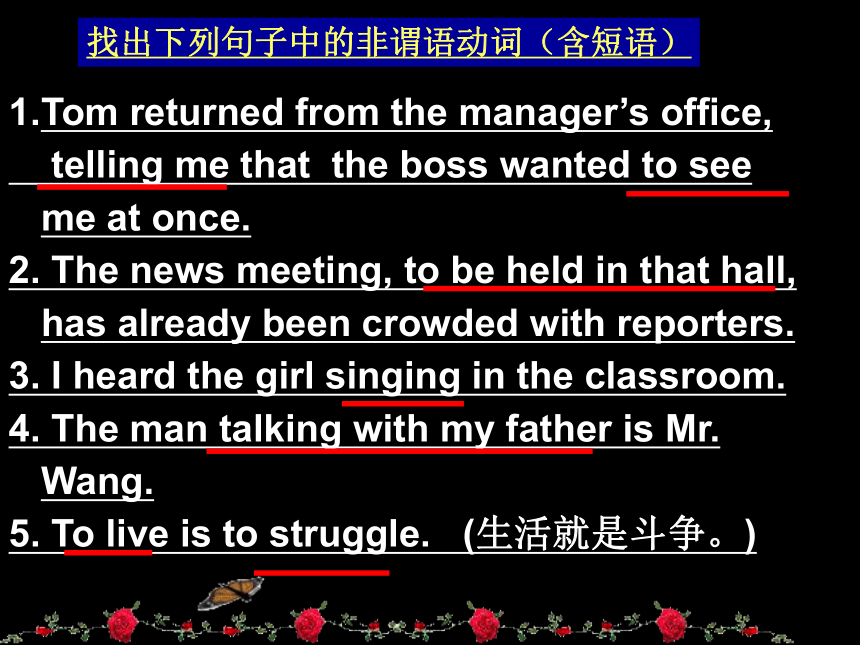



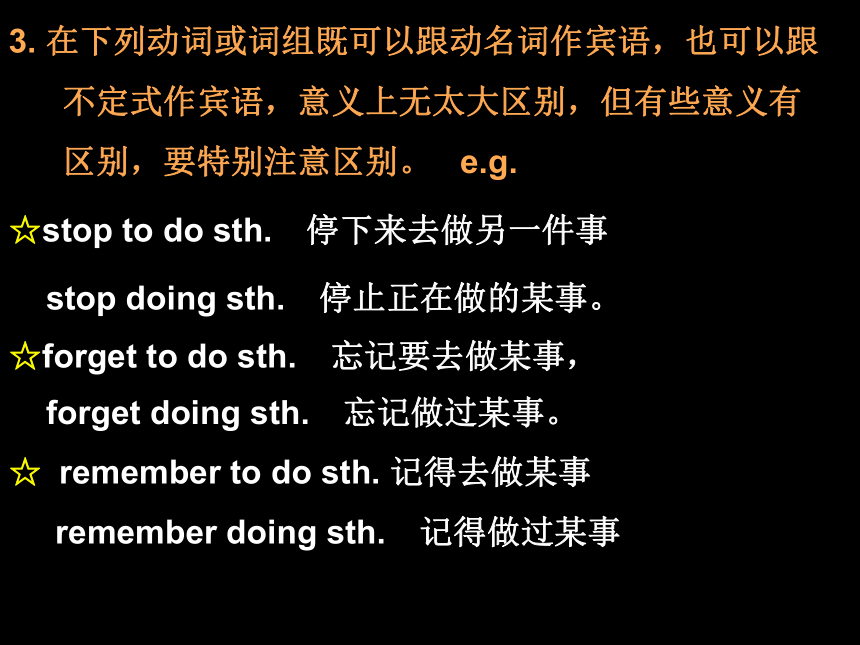
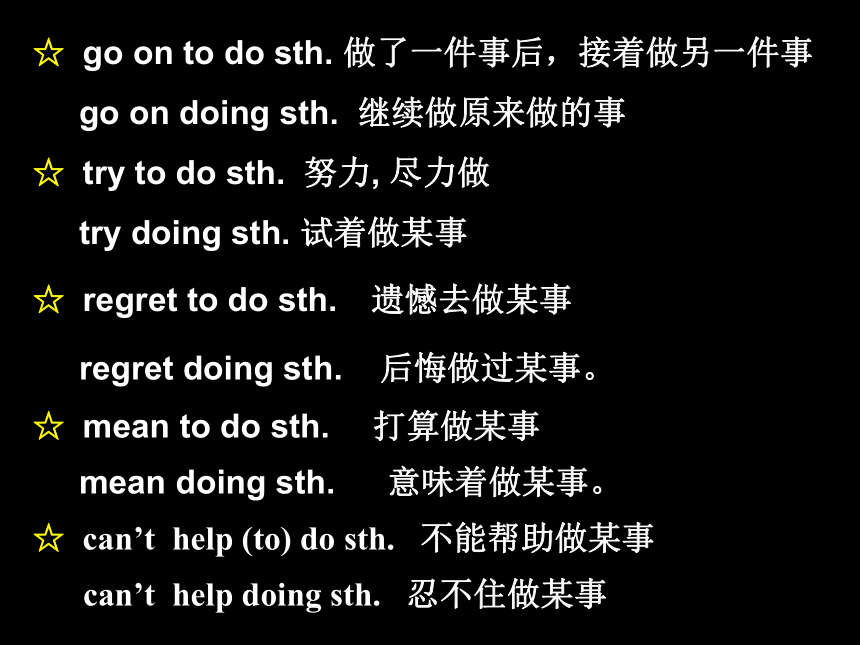
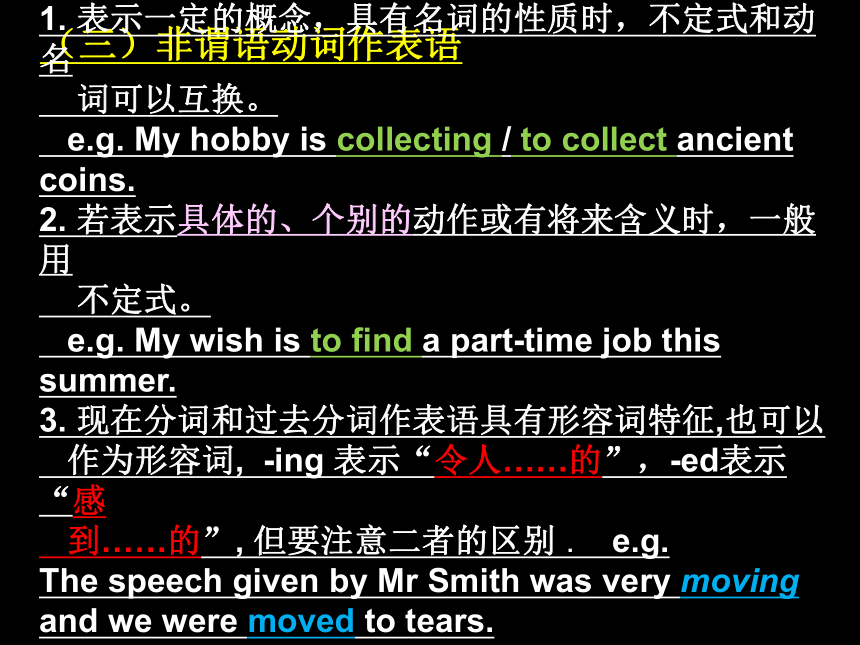

文档简介
课件47张PPT。Review of Non-finite verbs非谓语动词1. to do 2.doing 3.doneModule 2 Grammar非谓语不定式 (to do)V-ingV-edas a nounas adj. or adv.现在分词动名词过去分词非谓语动词的分类一个句子当中,已经存在一个主句(谓语动词),又没有连词的情况下, 还有别的动词出现时,这些动词就充当了非谓语动词.非谓语动词的
使用条件非谓语动词的否定形式Not + to do / -ing formHe decided not to do it.
She wished never to see him again.
Not seeing John, I asked where he was.
Not having done it right , I tried again.Tom returned from the manager’s office,
telling me that the boss wanted to see me at once.
2. The news meeting, to be held in that hall, has already been crowded with reporters.
3. I heard the girl singing in the classroom.
4. The man talking with my father is Mr. Wang.
5. To live is to struggle. (生活就是斗争。)找出下列句子中的非谓语动词(含短语)(一)不定式与动名词做主语:
动名词做主语或表语往往表示泛指的、一般的行为 ; 不定式 做主语或表语常表示某次具体的行为或将来的动作,非谓语做主语时,其谓语动词用第三人称单数。
e.g. Climbing mountains is great fun. 爬山很有趣。
To visit China is my next goal.
2. 不定式做主语,一般用it当形式主语,把作主语的不
定式短语后置。
e.g. It took me only five minutes to finish the job.
3. 动名词作主语有时用it作形式主语,把动名词置于句
尾。常见于以下句型中:
It is / was no use / good / fun / worth doing sth.
e.g It is no use crying over spilt milk . 覆水难收一、非谓语动词的句法功能 (二)不定式与动名词做宾语:1. 下列动词后常跟不定式做宾语: want, wish / hope, expect, ask / beg, afford, agree, choose, pretend, decide/determine, happen, learn, offer, refuse, fail, plan, prepare, order, manage, promise, intend等。 e.g.
He agreed to get someone to help us.
They promised not to break the school rules again.
2. 在下列动词或动词短语后常用动名词做宾语: admit, advise, allow, avoid, bear, cannot help, consider, delay, enjoy, finish, give up, imagine. include, keep, keep on, mind, miss, put off, permit, practice, resist, risk, suggest, stand, insist on, be busy, be worth, feel like, can’t stand, think of, dream of, be fond of, prevent…(from), keep…from, stop…(from), protect…from, be engaged in, spend…(in), succeed in, admit to, be/ get/ become used to, be equal to, devote…to, get down to, look forward to, object to, stick to, take to, see to, lead to, pay attention to等。 e.g.
He is used to getting up now . 注意:此to 为 prep. 介词+doing3. 在下列动词或词组既可以跟动名词作宾语,也可以跟不定式作宾语,意义上无太大区别,但有些意义有区别,要特别注意区别。 e.g.
☆stop to do sth. 停下来去做另一件事
stop doing sth. 停止正在做的某事。
☆forget to do sth. 忘记要去做某事,
forget doing sth. 忘记做过某事。
☆ remember to do sth. 记得去做某事
remember doing sth. 记得做过某事☆ go on to do sth. 做了一件事后,接着做另一件事
go on doing sth. 继续做原来做的事
☆ try to do sth. 努力, 尽力做
try doing sth. 试着做某事
☆ regret to do sth. 遗憾去做某事
regret doing sth. 后悔做过某事。
☆ mean to do sth. 打算做某事
mean doing sth. 意味着做某事。
☆ can’t help (to) do sth. 不能帮助做某事
can’t help doing sth. 忍不住做某事
(三)非谓语动词作表语 1. 表示一定的概念,具有名词的性质时,不定式和动名
词可以互换。
e.g. My hobby is collecting / to collect ancient coins.
2. 若表示具体的、个别的动作或有将来含义时,一般用
不定式。
e.g. My wish is to find a part-time job this summer.
3. 现在分词和过去分词作表语具有形容词特征,也可以
作为形容词, -ing 表示“令人……的”,-ed表示“感
到……的”, 但要注意二者的区别 . e.g.
The speech given by Mr Smith was very moving and we were moved to tears.(四)非谓语动词作定语 1. 不定式做定语放在所修饰的名词后,表示未发生的
动作或将要发生的某一动作。
e.g. The train to arrive is from London.
He is always the first to come and the last to leave.
2. 动名词做定语往往说明所修饰词的某种用途,一般
放在被修饰词的前面。
e.g. a washing machine (动名词做定语,= a machine
which is used for washing) 洗衣机
a reading room(动名词做定语,= a room which is
used for reading) 阅览室3. 现在分词作定语表示主动、进行的动作。过去
分词作定语则表示被动、或完成的意义。单个分词
或形容词性的分词作定语往往放在被修饰词的前
面;分词短语作定语多置于被修饰词后面。
e.g. the rising sun(现在分词做定语,= the sun which
is rising)正在升起的太阳
the changing world(现在分词做定语,= the world which is changing)变化中的世界
a moving movie 感人的电影 excited voice激动的声音 (形容词性分词作定语)
fallen leaves 落叶 a broken cup 一个破了的杯子
(过去分词作定语则表示被动、或完成)(五)动词不定式和分词作状语
动词不定式作 状语表示原因、目的和(预料之外的)结果;
分词作状语表示时间、原因、条件、方式、伴随状况
或(预料之中的)结果。 e.g.
George returned after the war, only to be told that his
wife had left him .
乔治战后归来,却被告知他的妻子已经离他而去。
The hurricane brought down a great number of houses, making thousands of people homeless.
飓风吹倒了大量的房子, 使得成千上万的人无家可归.
(六)不定式、现在分词、过去分词做补足语 1. 在“动词+宾语+不定式”结构中,不定式作宾语补足语,“宾语+不定式”构成了复合宾语。
有些动词要求不定式不带to,有些要求必须带to,还有的带与不带都可以。
● 以下动词后常跟带符号to的不定式做宾语补足语:
ask, tell, want, wish, order, persuade, advise, allow, warn,
encourage, cause, require等。
e.g. The doctor advised him to stay in bed for another few
days.
We wish him to remain and accept the post.
我们希望他留下来接受这个职位。2. 现在分词做补足语分两种情况:
● 形容词性质的现在分词作补足语:
e.g. I find the book very interesting.
我发现这本书非常有趣。(宾语补足语)
The boy is found very annoying.
发现这个小男孩很令人讨厌。(主语补足语)
● 动词性质的现在分词作补足语:感官动词和使役动
词,如see, watch, hear, feel, notice, observe, look at, listen
to, let, have, make, keep, get等后可以跟表示动作性质的
现在分词作补足语,表示“正在或持续做某事”。
e.g. I see him passing by a bank.
我看见他正经过一家银行。(宾语补足语)
He was seen working in the garden.
有人看见他正在花园里干活。(主语补足语) 感官动词(词组) see,watch,observe, look at,
notice, hear, listen to, feel的宾补有四种形式:
doing 看见……正在做……
do 看见做了
see+宾语+ being done 看见正在被做
done 看见被做
使役动词let,make, have ,get 后的复合宾语:
do 让……做……
done 让……被做
do sth. 使某人做某事
doing sth. 使…持续做某事
done使……被做let / make +宾语+ have / get +宾语+ 注意:被动语态中不能省去to.★★非谓语动词功能比较(以do为例)1.非谓语动词的七大经典原则
2.非谓语动词解题四大步骤非谓语动词题的做题技巧Practice一.非谓语动词的
七大经典原则
原则一:
When asked why he went there, he said he was sent there _____ for a space flight.
A. training B. being trained
C. to have trained D. to be trained
【解析】由于进行航空飞行训练是他被派往那儿的目的,所以要用不定式,因此可排除 A 和 B。另外,由于 “他”与“训练 ”为被动关系,
故选 D。
用作目的状语,原则上要用不定式
2.As the light turned green, I stood for a moment, not _____, and asked myself what I was going to do.
A. moved B. moving
C. to move D. Being moved【解析】由于与句子主语之间为主动关系,且表示当 时持续了一会儿,故用-ing。句意为:当信号灯变绿时,我站在那儿一会儿没动,心想自己该怎么办。
原则二:用作伴随状语,原则上要用-ing.原则三:
3. The glass doors have taken the place of the wooden ones at the entrance,_____ in the natural light during the day.
A. to let B. letting C. let D. having let
【解析] 此处用-ing 表示自然而然的结果。
如:It rained heavily, causing severe flooding in that place. 大雨滂沱,造成了那个地方洪水泛滥。用作结果状语时,可用-ing或不定式,其原则区别是:-ing 表示一定逻辑的结果,即意料之中或自然而然的结果。不定式表示非逻辑的结果,即意料之外的结果。4.He hurried to the station, only ______ that the
train had left.
A. to find B. finding
C. found D. to have found
【解析】only to do sth 在此表示出人意料的结果。原则四:
5.The children talked so loudly at dinner table that I had to struggle _____.
A. to be heard B. to have heard
C. hearing D. being heard
【解析】根据句意,此处指的是“被听见”,故要用被 动式,因可排除 B 和 C。另外,由于“设法被听见”为目的状语,动作当时尚未发生,故用不定式,即选 A。 凡是含有被动意义时,原则上要用过去分词。
但是,如果所涉及的动作尚未发生,则用不定式的被动
式;如果所涉及的动作正在进行,则用-ing的被动式原则五:非谓语动词作状语时,其逻辑主语原则上应与主句主语保持一致.
6. Faced with (=Facing) a bill for $10,000,_____.
A. John has taken an extra job
B. the boss has given John an extra job
C. an extra job has been taken
D. an extra job has been given to John(be) faced with…Faced with 原则六:强调动作发生在主句谓语动作之前时,原则上要用完成式 (根据情况可用不定式的完成式或 —ing的完成式)
7._____ from other continents for millions of years, Australia has many plants and animals not found in any other countries in the world.
A. Being separated B. Having separated
C. Having been separated D. to be separated【解析】因为 Australia 与 separate 是被动关系,且 separate发生在谓语动词 has 之前,所以用-ing的完成被动式作原因状语。has原则七:用于名词后作定语时,原则是:
用不定式,表示动作尚未发生;
用-ing,表示动作正在进行;
用过去分词,表示动作被动、完成。
8.There will be more than three hundred scientists
attending the meeting _____ the day after tomorrow.
A. hold B. holding C. held D. to be held
9. There are hundreds of visitors _____ in front of
the Art Gallery to have a look at Van Gogh’s paintings.
A. waited B. to wait C. waiting D. wait
the meeting the day after tomorrowvisitors 10. —The last one _____ pays the meal.
—Agreed!
A. arrived B. arrives
C. to arrive D. arriving
The last one注:受 the first, the second ... the last 修饰
的名词或代词后原则上要用不定式作定语。 You are the second to make that mistake.
你是第二个犯这错误的人。二. 非谓语动词解题
四大步骤(一)分析句子结构,辨别“谓语与非谓语”11.______many times , but he still couldn't understand it .12. ____ many times , he still couldn't understand it .Having been told B. Being told
C. He had been told D. Though he was toldC___A注意连词 (二)找逻辑主语13.Walking along the street one day, she saw
a little girl running up to her.
14.She is reading a book found on the way.
15.Most of the artists invited to the party were
from South Africa.
一般来说,
非谓语动词作状语,逻辑主语是句子的主语;
非谓语动词作宾补,逻辑主语是宾语;
非谓语动词作定语,逻辑主语是被修饰词。非谓语动词虽不能作谓语,但仍具有动词特点,其逻辑上的动作执行者就叫做逻辑主语,特别是当非谓语动词作状语时,其逻辑主语通常是主句的主语,若不然,则得加上自己的逻辑主语,这时就构成独立主格。一般说来,
非谓语动词作定语时,逻辑主语为其所修饰的名词;
作宾语补足语,逻辑主语为宾语补足语之前的宾语;
作表语、宾语或状语时,其逻辑主语通常为主句的主语,
分析语态就是在确定逻辑主语之后,分析非谓语动词和逻辑主语在搭配使用时是主动还是被动关系。 16.______from space , the earth looks blue .
17.______from space , we can see the earth is blue .
A. Seen B. Seeing C. To see D. SeeAB解析:句1. “地球”被“看起来”,表被动,故选A,
用过去分词表被动。 句2. 我们"主动看......"即表主动,故选B。(三)分析语态(四)分析时态18. The building ____ now will be a restaurant .19. The building ____ next year will be a restaurant .20. The building _____ last year is a restaurant.having been built B.to be built
C.being built D. built ___C ______B______DConclusion原则一:用作目的状语,原则上要用_______.原则二:用作伴随状语,原则上要用________原则三:用作结果状语时,可用 -ing或不定式
.原则四:凡是含有被动意义时,原则上要用________。原则五:非谓语动词作状语时,其逻辑主语原则上应与 主句主语___________ .原则六:强调动作发生在主句谓语动作之前时,原则上要用________ .原则七:用于名词后作定语时,原则是:用_______,表示动作尚未发生; 用_____,表示动作正在进行; 用________ ,表示动作已经发生,同时表示被动意义英语非谓语动词题的七条经典原则不定式现在分词过去分词保持一致完成式不定式-ing过去分词二. 找逻辑主语三、分析语态四、分析时态辨别“谓与非谓”
(注意连词 、 标点符号) 非谓语动词解题步骤方法总结:
谓非谓,找主语,析语态,定时态 Exercises
I. Fill in the blanks with the correct forms of the verbs.
1.The man with the gun had a __________ (satisfy)
expression on his face .
2. I’d like _________ (read ) novels written by Lu Xun.
3. I advise her _______ ( buy ) a new dictionary .
4. I’ll have my bike __________ (repair ) this afternoon .
5. He was always the first __________ (come)and
the last _________ ( leave ) the office.
6.The plane crashed, ________ ( kill ) all 200 people aboard.
7. ___________ ( listen ) to light music makes me
relaxed after a day’s work .
8. His first book _________________ ( publish ) next month
is based on a true story .satisfiedto readto buyrepairedto cometo leavekillingListeningto be published
II. Choose the best answer.
______ which university to attend, the
girl asked her teacher for advice. (2013.四川)
A. Not konwing B. Knowing not
C. Not known D. Known not
【解析】 句意:由于不知道上那所大学,那个女孩向她的老师征求意见。分析句子成分可知,the girl 与know 之间是逻辑上的主动关系,所以用现在分词作原因状语,且分词的否定形式是在分词前加not, 所以答案为 A. 高考链接2. ______ at the cafeteria before, Tina
didn’t want to eat there again (2013.山东)
A. Having eaten B. To eat
C. Eat D. Eating
【解析】 句意:在那个餐厅吃过饭,蒂娜不想再在那里吃了。分析句子结构和句意可知,Tina与eat 之间是主动关系,且eat这一动作发生在谓语动词“didn’t want” 所表示的动作之前,所以用动词-ing形式的完成时作状语。故选A。3. _______ basic first-aid techniques will
help you respond quickly to emergencies .
(2013福建)
A. Known B. Having known
C. Knowing D. Being known
【解析】 句意:了解基本的急救技巧能帮助你快速应对紧急情况。分析句子结构可知,空处在句子中充当主语,应用动词-ing形式。Having known 强调“完成”,不符合句意,可排除。故选C。 4.Alexander tried to get his work _______
in the medical circle . (2010辽宁)
A. to recognize B. recognizing
C. recognize D. recognized
【解析】 句意:亚历山大试图使他的工作被医学界认可。分析句子结构可知,空处在句子中充当宾补, recognize与 his work之间是动宾关系,所以应用动词-ed形式表被动。故选D。 5. Tom took a taxi to the airport, only _____
his plane high up in th sky. (2012四川)
A. finding B. to find
C. being found D. to have found
【解析】 句意:汤姆乘的的士赶到机场,结果只发现他要乘坐的飞机已经飞入高空了。此处only后接动词不定式to do 表示意想不到的结果。故选B。 A. Find B. Finding
C. To find D. Found6. ______the course very difficult, she decided
to move to a lower level. (2013. 北京) When ______ for his view about his
teaching job, Philip said he found it
very interesting and rewarding.(2012.安徽)
_____A. asking B. asked
C. having asked D. to be asked8. With Father’s Day around the corner, I have
taken some money out of the bank ______
present for my dad. (2010.课标全国 ) buy B. to buy
C. buy D. to have bought9. Tony lent me the money, _____ that
I’d do as much for him. (2012全国II)
A. hoping B. to hope
C. hoped D. having hoped___10. When we saw the road _____with
snow, we decided to spend the
holiday at home .
A. block B. to block
C. blocking D. blocked___
使用条件非谓语动词的否定形式Not + to do / -ing formHe decided not to do it.
She wished never to see him again.
Not seeing John, I asked where he was.
Not having done it right , I tried again.Tom returned from the manager’s office,
telling me that the boss wanted to see me at once.
2. The news meeting, to be held in that hall, has already been crowded with reporters.
3. I heard the girl singing in the classroom.
4. The man talking with my father is Mr. Wang.
5. To live is to struggle. (生活就是斗争。)找出下列句子中的非谓语动词(含短语)(一)不定式与动名词做主语:
动名词做主语或表语往往表示泛指的、一般的行为 ; 不定式 做主语或表语常表示某次具体的行为或将来的动作,非谓语做主语时,其谓语动词用第三人称单数。
e.g. Climbing mountains is great fun. 爬山很有趣。
To visit China is my next goal.
2. 不定式做主语,一般用it当形式主语,把作主语的不
定式短语后置。
e.g. It took me only five minutes to finish the job.
3. 动名词作主语有时用it作形式主语,把动名词置于句
尾。常见于以下句型中:
It is / was no use / good / fun / worth doing sth.
e.g It is no use crying over spilt milk . 覆水难收一、非谓语动词的句法功能 (二)不定式与动名词做宾语:1. 下列动词后常跟不定式做宾语: want, wish / hope, expect, ask / beg, afford, agree, choose, pretend, decide/determine, happen, learn, offer, refuse, fail, plan, prepare, order, manage, promise, intend等。 e.g.
He agreed to get someone to help us.
They promised not to break the school rules again.
2. 在下列动词或动词短语后常用动名词做宾语: admit, advise, allow, avoid, bear, cannot help, consider, delay, enjoy, finish, give up, imagine. include, keep, keep on, mind, miss, put off, permit, practice, resist, risk, suggest, stand, insist on, be busy, be worth, feel like, can’t stand, think of, dream of, be fond of, prevent…(from), keep…from, stop…(from), protect…from, be engaged in, spend…(in), succeed in, admit to, be/ get/ become used to, be equal to, devote…to, get down to, look forward to, object to, stick to, take to, see to, lead to, pay attention to等。 e.g.
He is used to getting up now . 注意:此to 为 prep. 介词+doing3. 在下列动词或词组既可以跟动名词作宾语,也可以跟不定式作宾语,意义上无太大区别,但有些意义有区别,要特别注意区别。 e.g.
☆stop to do sth. 停下来去做另一件事
stop doing sth. 停止正在做的某事。
☆forget to do sth. 忘记要去做某事,
forget doing sth. 忘记做过某事。
☆ remember to do sth. 记得去做某事
remember doing sth. 记得做过某事☆ go on to do sth. 做了一件事后,接着做另一件事
go on doing sth. 继续做原来做的事
☆ try to do sth. 努力, 尽力做
try doing sth. 试着做某事
☆ regret to do sth. 遗憾去做某事
regret doing sth. 后悔做过某事。
☆ mean to do sth. 打算做某事
mean doing sth. 意味着做某事。
☆ can’t help (to) do sth. 不能帮助做某事
can’t help doing sth. 忍不住做某事
(三)非谓语动词作表语 1. 表示一定的概念,具有名词的性质时,不定式和动名
词可以互换。
e.g. My hobby is collecting / to collect ancient coins.
2. 若表示具体的、个别的动作或有将来含义时,一般用
不定式。
e.g. My wish is to find a part-time job this summer.
3. 现在分词和过去分词作表语具有形容词特征,也可以
作为形容词, -ing 表示“令人……的”,-ed表示“感
到……的”, 但要注意二者的区别 . e.g.
The speech given by Mr Smith was very moving and we were moved to tears.(四)非谓语动词作定语 1. 不定式做定语放在所修饰的名词后,表示未发生的
动作或将要发生的某一动作。
e.g. The train to arrive is from London.
He is always the first to come and the last to leave.
2. 动名词做定语往往说明所修饰词的某种用途,一般
放在被修饰词的前面。
e.g. a washing machine (动名词做定语,= a machine
which is used for washing) 洗衣机
a reading room(动名词做定语,= a room which is
used for reading) 阅览室3. 现在分词作定语表示主动、进行的动作。过去
分词作定语则表示被动、或完成的意义。单个分词
或形容词性的分词作定语往往放在被修饰词的前
面;分词短语作定语多置于被修饰词后面。
e.g. the rising sun(现在分词做定语,= the sun which
is rising)正在升起的太阳
the changing world(现在分词做定语,= the world which is changing)变化中的世界
a moving movie 感人的电影 excited voice激动的声音 (形容词性分词作定语)
fallen leaves 落叶 a broken cup 一个破了的杯子
(过去分词作定语则表示被动、或完成)(五)动词不定式和分词作状语
动词不定式作 状语表示原因、目的和(预料之外的)结果;
分词作状语表示时间、原因、条件、方式、伴随状况
或(预料之中的)结果。 e.g.
George returned after the war, only to be told that his
wife had left him .
乔治战后归来,却被告知他的妻子已经离他而去。
The hurricane brought down a great number of houses, making thousands of people homeless.
飓风吹倒了大量的房子, 使得成千上万的人无家可归.
(六)不定式、现在分词、过去分词做补足语 1. 在“动词+宾语+不定式”结构中,不定式作宾语补足语,“宾语+不定式”构成了复合宾语。
有些动词要求不定式不带to,有些要求必须带to,还有的带与不带都可以。
● 以下动词后常跟带符号to的不定式做宾语补足语:
ask, tell, want, wish, order, persuade, advise, allow, warn,
encourage, cause, require等。
e.g. The doctor advised him to stay in bed for another few
days.
We wish him to remain and accept the post.
我们希望他留下来接受这个职位。2. 现在分词做补足语分两种情况:
● 形容词性质的现在分词作补足语:
e.g. I find the book very interesting.
我发现这本书非常有趣。(宾语补足语)
The boy is found very annoying.
发现这个小男孩很令人讨厌。(主语补足语)
● 动词性质的现在分词作补足语:感官动词和使役动
词,如see, watch, hear, feel, notice, observe, look at, listen
to, let, have, make, keep, get等后可以跟表示动作性质的
现在分词作补足语,表示“正在或持续做某事”。
e.g. I see him passing by a bank.
我看见他正经过一家银行。(宾语补足语)
He was seen working in the garden.
有人看见他正在花园里干活。(主语补足语) 感官动词(词组) see,watch,observe, look at,
notice, hear, listen to, feel的宾补有四种形式:
doing 看见……正在做……
do 看见做了
see+宾语+ being done 看见正在被做
done 看见被做
使役动词let,make, have ,get 后的复合宾语:
do 让……做……
done 让……被做
do sth. 使某人做某事
doing sth. 使…持续做某事
done使……被做let / make +宾语+ have / get +宾语+ 注意:被动语态中不能省去to.★★非谓语动词功能比较(以do为例)1.非谓语动词的七大经典原则
2.非谓语动词解题四大步骤非谓语动词题的做题技巧Practice一.非谓语动词的
七大经典原则
原则一:
When asked why he went there, he said he was sent there _____ for a space flight.
A. training B. being trained
C. to have trained D. to be trained
【解析】由于进行航空飞行训练是他被派往那儿的目的,所以要用不定式,因此可排除 A 和 B。另外,由于 “他”与“训练 ”为被动关系,
故选 D。
用作目的状语,原则上要用不定式
2.As the light turned green, I stood for a moment, not _____, and asked myself what I was going to do.
A. moved B. moving
C. to move D. Being moved【解析】由于与句子主语之间为主动关系,且表示当 时持续了一会儿,故用-ing。句意为:当信号灯变绿时,我站在那儿一会儿没动,心想自己该怎么办。
原则二:用作伴随状语,原则上要用-ing.原则三:
3. The glass doors have taken the place of the wooden ones at the entrance,_____ in the natural light during the day.
A. to let B. letting C. let D. having let
【解析] 此处用-ing 表示自然而然的结果。
如:It rained heavily, causing severe flooding in that place. 大雨滂沱,造成了那个地方洪水泛滥。用作结果状语时,可用-ing或不定式,其原则区别是:-ing 表示一定逻辑的结果,即意料之中或自然而然的结果。不定式表示非逻辑的结果,即意料之外的结果。4.He hurried to the station, only ______ that the
train had left.
A. to find B. finding
C. found D. to have found
【解析】only to do sth 在此表示出人意料的结果。原则四:
5.The children talked so loudly at dinner table that I had to struggle _____.
A. to be heard B. to have heard
C. hearing D. being heard
【解析】根据句意,此处指的是“被听见”,故要用被 动式,因可排除 B 和 C。另外,由于“设法被听见”为目的状语,动作当时尚未发生,故用不定式,即选 A。 凡是含有被动意义时,原则上要用过去分词。
但是,如果所涉及的动作尚未发生,则用不定式的被动
式;如果所涉及的动作正在进行,则用-ing的被动式原则五:非谓语动词作状语时,其逻辑主语原则上应与主句主语保持一致.
6. Faced with (=Facing) a bill for $10,000,_____.
A. John has taken an extra job
B. the boss has given John an extra job
C. an extra job has been taken
D. an extra job has been given to John(be) faced with…Faced with 原则六:强调动作发生在主句谓语动作之前时,原则上要用完成式 (根据情况可用不定式的完成式或 —ing的完成式)
7._____ from other continents for millions of years, Australia has many plants and animals not found in any other countries in the world.
A. Being separated B. Having separated
C. Having been separated D. to be separated【解析】因为 Australia 与 separate 是被动关系,且 separate发生在谓语动词 has 之前,所以用-ing的完成被动式作原因状语。has原则七:用于名词后作定语时,原则是:
用不定式,表示动作尚未发生;
用-ing,表示动作正在进行;
用过去分词,表示动作被动、完成。
8.There will be more than three hundred scientists
attending the meeting _____ the day after tomorrow.
A. hold B. holding C. held D. to be held
9. There are hundreds of visitors _____ in front of
the Art Gallery to have a look at Van Gogh’s paintings.
A. waited B. to wait C. waiting D. wait
the meeting the day after tomorrowvisitors 10. —The last one _____ pays the meal.
—Agreed!
A. arrived B. arrives
C. to arrive D. arriving
The last one注:受 the first, the second ... the last 修饰
的名词或代词后原则上要用不定式作定语。 You are the second to make that mistake.
你是第二个犯这错误的人。二. 非谓语动词解题
四大步骤(一)分析句子结构,辨别“谓语与非谓语”11.______many times , but he still couldn't understand it .12. ____ many times , he still couldn't understand it .Having been told B. Being told
C. He had been told D. Though he was toldC___A注意连词 (二)找逻辑主语13.Walking along the street one day, she saw
a little girl running up to her.
14.She is reading a book found on the way.
15.Most of the artists invited to the party were
from South Africa.
一般来说,
非谓语动词作状语,逻辑主语是句子的主语;
非谓语动词作宾补,逻辑主语是宾语;
非谓语动词作定语,逻辑主语是被修饰词。非谓语动词虽不能作谓语,但仍具有动词特点,其逻辑上的动作执行者就叫做逻辑主语,特别是当非谓语动词作状语时,其逻辑主语通常是主句的主语,若不然,则得加上自己的逻辑主语,这时就构成独立主格。一般说来,
非谓语动词作定语时,逻辑主语为其所修饰的名词;
作宾语补足语,逻辑主语为宾语补足语之前的宾语;
作表语、宾语或状语时,其逻辑主语通常为主句的主语,
分析语态就是在确定逻辑主语之后,分析非谓语动词和逻辑主语在搭配使用时是主动还是被动关系。 16.______from space , the earth looks blue .
17.______from space , we can see the earth is blue .
A. Seen B. Seeing C. To see D. SeeAB解析:句1. “地球”被“看起来”,表被动,故选A,
用过去分词表被动。 句2. 我们"主动看......"即表主动,故选B。(三)分析语态(四)分析时态18. The building ____ now will be a restaurant .19. The building ____ next year will be a restaurant .20. The building _____ last year is a restaurant.having been built B.to be built
C.being built D. built ___C ______B______DConclusion原则一:用作目的状语,原则上要用_______.原则二:用作伴随状语,原则上要用________原则三:用作结果状语时,可用 -ing或不定式
.原则四:凡是含有被动意义时,原则上要用________。原则五:非谓语动词作状语时,其逻辑主语原则上应与 主句主语___________ .原则六:强调动作发生在主句谓语动作之前时,原则上要用________ .原则七:用于名词后作定语时,原则是:用_______,表示动作尚未发生; 用_____,表示动作正在进行; 用________ ,表示动作已经发生,同时表示被动意义英语非谓语动词题的七条经典原则不定式现在分词过去分词保持一致完成式不定式-ing过去分词二. 找逻辑主语三、分析语态四、分析时态辨别“谓与非谓”
(注意连词 、 标点符号) 非谓语动词解题步骤方法总结:
谓非谓,找主语,析语态,定时态 Exercises
I. Fill in the blanks with the correct forms of the verbs.
1.The man with the gun had a __________ (satisfy)
expression on his face .
2. I’d like _________ (read ) novels written by Lu Xun.
3. I advise her _______ ( buy ) a new dictionary .
4. I’ll have my bike __________ (repair ) this afternoon .
5. He was always the first __________ (come)and
the last _________ ( leave ) the office.
6.The plane crashed, ________ ( kill ) all 200 people aboard.
7. ___________ ( listen ) to light music makes me
relaxed after a day’s work .
8. His first book _________________ ( publish ) next month
is based on a true story .satisfiedto readto buyrepairedto cometo leavekillingListeningto be published
II. Choose the best answer.
______ which university to attend, the
girl asked her teacher for advice. (2013.四川)
A. Not konwing B. Knowing not
C. Not known D. Known not
【解析】 句意:由于不知道上那所大学,那个女孩向她的老师征求意见。分析句子成分可知,the girl 与know 之间是逻辑上的主动关系,所以用现在分词作原因状语,且分词的否定形式是在分词前加not, 所以答案为 A. 高考链接2. ______ at the cafeteria before, Tina
didn’t want to eat there again (2013.山东)
A. Having eaten B. To eat
C. Eat D. Eating
【解析】 句意:在那个餐厅吃过饭,蒂娜不想再在那里吃了。分析句子结构和句意可知,Tina与eat 之间是主动关系,且eat这一动作发生在谓语动词“didn’t want” 所表示的动作之前,所以用动词-ing形式的完成时作状语。故选A。3. _______ basic first-aid techniques will
help you respond quickly to emergencies .
(2013福建)
A. Known B. Having known
C. Knowing D. Being known
【解析】 句意:了解基本的急救技巧能帮助你快速应对紧急情况。分析句子结构可知,空处在句子中充当主语,应用动词-ing形式。Having known 强调“完成”,不符合句意,可排除。故选C。 4.Alexander tried to get his work _______
in the medical circle . (2010辽宁)
A. to recognize B. recognizing
C. recognize D. recognized
【解析】 句意:亚历山大试图使他的工作被医学界认可。分析句子结构可知,空处在句子中充当宾补, recognize与 his work之间是动宾关系,所以应用动词-ed形式表被动。故选D。 5. Tom took a taxi to the airport, only _____
his plane high up in th sky. (2012四川)
A. finding B. to find
C. being found D. to have found
【解析】 句意:汤姆乘的的士赶到机场,结果只发现他要乘坐的飞机已经飞入高空了。此处only后接动词不定式to do 表示意想不到的结果。故选B。 A. Find B. Finding
C. To find D. Found6. ______the course very difficult, she decided
to move to a lower level. (2013. 北京) When ______ for his view about his
teaching job, Philip said he found it
very interesting and rewarding.(2012.安徽)
_____A. asking B. asked
C. having asked D. to be asked8. With Father’s Day around the corner, I have
taken some money out of the bank ______
present for my dad. (2010.课标全国 ) buy B. to buy
C. buy D. to have bought9. Tony lent me the money, _____ that
I’d do as much for him. (2012全国II)
A. hoping B. to hope
C. hoped D. having hoped___10. When we saw the road _____with
snow, we decided to spend the
holiday at home .
A. block B. to block
C. blocking D. blocked___
